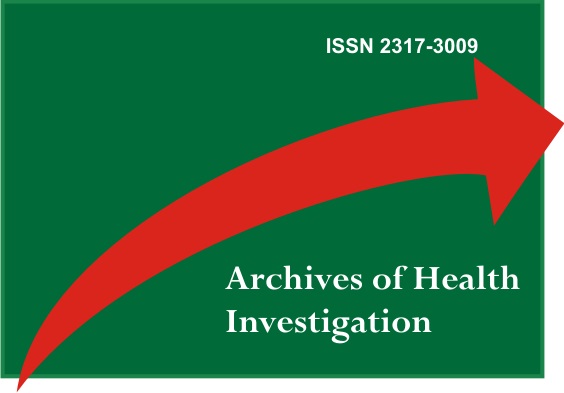Oral Devices for the Treatment of Sleep Apnea: Literature Review
DOI:
https://doi.org/10.21270/archi.v13i1.5817Keywords:
Obstructive Sleep Apnea, Therapeutics, Mandibular AdvancementAbstract
Introduction: Obstructive Sleep Apnea (OSA) is a disorder characterized by intermittent collapse of the upper airways that affects about 30% of the adult population and can be treated with oral devices. Objective: To present a narrative review of the literature on the use and effectiveness of oral devices for the treatment of OSA. Material and method: The terms “Obstructive Sleep Apnea”, “Treatment”, “Mandibular Advancement”, “Oral Appliances” were searched in Pubmed/Medline and Google Schoolar databases between 2009 and 2020 and 20 articles were selected for compose the literature review. Results: A widely discussed treatment for OSA is continuous positive airway pressure therapy; however, this therapy has flaws due to intolerance and poor adherence by patients. Thus, oral devices are discussed as the main alternative to this treatment. The most commonly used devices are mandibular advancement devices and tongue retainers, controllers or stabilizers, as they are considered effective and safe for the treatment of OSA as they improve polysomnographic parameters, such as the apnea-hypopnea index, significantly reducing snoring and excessive daytime sleepiness. Although side effects exist, these devices are also capable of having a positive effect on minimum oxygen saturation and are generally well accepted by patients. Conclusion: The Dental Surgeon has gained a very important role in recognizing sleep disorders, referring their patients to a specialized doctor and, when indicated, offering treatment with oral devices.
Downloads
References
Cohen-Levy J, Garcia R, Pételle B, Fleury B. Treatment of the obstructive sleep apnea syndrome in adults by mandibular advancement device: the state of the art. Int Orthod. 2009;7(3):287-304.
Basyuni S, Barabas M, Quinnell T. An update on mandibular advancement devices for the treatment of obstructive sleep apnoea hypopnoea syndrome. J Thorac Dis. 2018;10(1):S48-56.
Miljus D, Tihacek-Sojic L, Lemic AM, Andjelkovic M. Treatment of obstructive sleep apnea patients using oral appliances--our experiences. Vojnosanit Pregl. 2014;71(7):623-6.
Rundo JV. Obstructive sleep apnea basics. Cleve Clin J Med. 2019;86(9):2-9.
Sampol Rubio G, Macías Escalada E, Montserrat Canal JM, Terán Santos J. Mandibular advancement devices in the treatment of obstructive sleep apnea. A necessary and effective option. Med Clin. 2018;151(1):34-8.
Ferraz PD, Borges MI, Silva MR, Carvalho F, Moita J, Figueiredo JP. Eficácia de dispositivo de avanço mandibular no tratamento de doentes com Síndrome da Apneia Obstrutiva do Sono – estudo retrospetivo. Rev Port Estomatol Med Dent Cir Maxillofac. 2020;61(3):117-21.
Ng JH, Yow M. Oral appliances in the management of obstructive sleep apnea. Sleep Med Clin. 2010;14(1):109-18.
Deane SA, Cistulli PA, Ng AT, Zeng B, Petocz P, Darendeliler MA. Comparison of mandibular advancement splint and tongue stabilizing device in obstructive sleep apnea: a randomized controlled trial. Sleep. 2009;32(5):648-53.
Aarab G, Lobbezoo F, Heymans MW, Hamburger HL, Naeije M. Long-term follow-up of a randomized controlled trial of oral appliance therapy in obstructive sleep apnea. Respiration. 2011;82(2):162-8.
Dieltjens M, Vanderveken OM, Hamans E, Verbraecken JA, Wouters K, Willemen M, et al. Treatment of obstructive sleep apnea using a custom-made titratable duobloc oral appliance: a prospective clinical study. Sleep Breath. 2013;17(2):565-572.
De Britto Teixeira AO, Abi-Ramia LB, De Oliveira Almeida MA. Treatment of obstructive sleep apnea with oral appliances. Prog Orthod. 2013;14:10.
Doff MH, Hoekema A, Wijkstra PJ, et al. Oral appliance versus continuous positive airway pressure in obstructive sleep apnea syndrome: a 2-year follow-up. Sleep. 2013;36(9):1289-96
Giannasi LC, Almeida FR, Nacif SR, de Oliveira LV. Efficacy of an oral appliance for the treatment of obstructive sleep apnea. Int J Prosthodont. 2013;26(4):334-9.
Ngiam J, Balasubramaniam R, Darendeliler MA, Cheng AT, Waters K, Sullivan CE. Clinical guidelines for oral appliance therapy in the treatment of snoring and obstructive sleep apnoea. Aust Dent J. 2013;58(4):408-19.
Phillips CL, Grunstein RR, Darendeliler MA, Mihailidou AS, Srinivasan VK, Yee BJ, et al. Health outcomes of continuous positive airway pressure versus oral appliance treatment for obstructive sleep apnea: a randomized controlled trial. Am J Respir Crit Care Med. 2013;187(8):879-87.
Durán-Cantolla J, Crovetto-Martínez R, Alkhraisat MH, Crovetto M, Municio A, Kutz R, et al. Efficacy of mandibular advancement device in the treatment of obstructive sleep apnea syndrome: A randomized controlled crossover clinical trial. Med Oral Patol Oral Cir Bucal. 2015;20(5):e605-15.
Marklund M. Long-term efficacy of an oral appliance in early treated patients with obstructive sleep apnea. Sleep Breath. 2016;20(2):689-94.
Serra-Torres S, Bellot-Arcís C, Montiel-Company JM, Marco-Algarra J, Almerich-Silla JM. Effectiveness of mandibular advancement appliances in treating obstructive sleep apnea syndrome: A systematic review. Laryngoscope. 2016;126(2):507-14.
Al-Dharrab A. A randomized cross over study comparing the efficacy of two mandibular advancement appliances in the treatment of mild-moderate obstructive sleep apnea. Cranio. 2017;35(6):379-84.
Isacsson G, Fodor C, Sturebrand M. Obstructive sleep apnea treated with custom-made bibloc and monobloc oral appliances: a retrospective comparative study. Sleep Breath. 2017;21(1):93-100.
Guimarães MLR, Hermont AP, de Azevedo PG, Bastos PL, de Oliveira MTP, de Melo IM, et al. Severe obstructive sleep apnea treatment with oral appliance: the impact on obstructive, central and mixed events. Sleep Breath. 2018;22(1):91-98.
Dieltjens M, Vanderveken O. Oral appliances in obstructive sleep apnea. Healthcare. 2019;7(4):141.
Mickelson SA. Oral appliances for snoring and obstructive sleep apnea. tolaryngol Clin North Am. 2020;53(3):397-407.
Uniken Venema JAM, Doff MHJ, Joffe-Sokolova D, Wijkstra PJ, van der Hoeven JH, Stegenga B, et al. Long-term obstructive sleep apnea therapy: a 10-year follow-up of mandibular advancement device and continuous positive airway pressure. J Clin Sleep Med. 2020;16(3):353-359.


